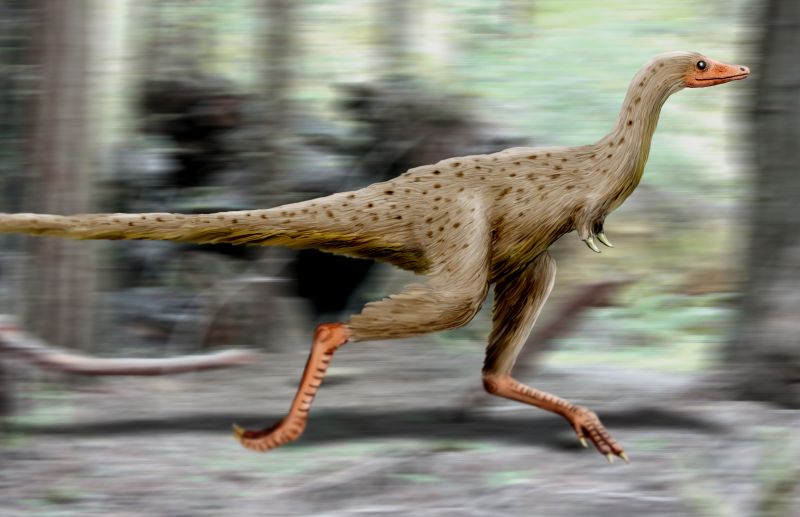|
Alvarezsaurid
Alvarezsauridae is a family of small, long-legged dinosaurs. Although originally thought to represent the earliest known flightless birds, they are now thought to be an early diverging branch of maniraptoran theropods. Alvarezsaurids were highly specialized. They had tiny but stout forelimbs, with compact, bird-like hands. Their skeletons suggest that they had massive breast and arm muscles, possibly adapted for digging or tearing. They had long, tube-shaped snouts filled with tiny teeth. They have been interpreted as myrmecophagous, adapted to prey on colonial insects such as termites, with the short arms acting as effective digging instruments to break into nests. '' Alvarezsaurus'', the type genus of the family, was named for the historian Gregorio Álvarez. History of study Bonaparte (1991) described the first alvarezsaurid, '' Alvarezsaurus calvoi'', from an incomplete skeleton found in Patagonia, Argentina. Bonaparte also named a family, Alvarezsauridae, to contain it. ... [...More Info...] [...Related Items...] OR: [Wikipedia] [Google] [Baidu] |
Bonapartenykus
''Bonapartenykus'' (meaning " José F. Bonaparte's claw") is a monospecific genus of alvarezsauroid dinosaur from Argentina that lived during the Late Cretaceous (Campanian-Maastrichtian) in what is now the upper Allen Formation of the Río Negro Province. The type and only species, ''Bonapartenykus ultimus'', is known from a nearly articulated but partial skeleton that was found in close association to two incomplete eggs and several clusters of eggshells belonging to the oogenus ''Arriagadoolithus''. ''Bonapartenykus'' was named in 2012 by Federico L. Agnolin, Jaime E. Powell, Fernando E. Novas and Martin Kundrát. ''Bonapartenykus'' has an estimated length of and weight of , making it the largest member of the clade Alvarezsauroidea. Discovery and Naming A partial skeleton of a theropod with eggs was collected in a surface of approximately 30 m2 in fluvial sandstones of the upper Allen Formation in northwestern Patagonia, Argentina. The locality has also produced specimen ... [...More Info...] [...Related Items...] OR: [Wikipedia] [Google] [Baidu] |
Ceratonykus
''Ceratonykus'' (meaning "horned claw") is a monospecific genus of alvarezsaurid dinosaur from Mongolia that lived during the Late Cretaceous (late Campanian stage, 72.1 Ma) in what is now the Barun Goyot Formation. The type and only species, ''Ceratonykus oculatus'', is known from a fragmentary skeleton, including an incomplete skull, of an adult individual. It was named and described in 2009 by Vladimir Alifanov and Rinchen Barsbold. Its describers questioned the traditional placement of alvarezsaurs in Theropoda, instead suggesting they were ornithischians, but this has not been accepted since. ''Ceratonykus'' has an estimated length of 75 centimetres (2.5 feet) and weight of 760 grams (1.68 lbs). It has been considered as a possible junior synonym of '' Parvicursor''. Discovery and naming In 2003, a partial skeleton of an alvarezsaurid was discovered in the Barun Goyot Formation of the Khermiin Tsav locality, Mongolia by the Paleontological Center of the Mongolian Academy ... [...More Info...] [...Related Items...] OR: [Wikipedia] [Google] [Baidu] |
Trierarchuncus
''Trierarchuncus'' (meaning "captain hook," after its single-clawed hands) is a monotypic genus of alvarezsaurid theropod which includes a single species, ''Trierarchuncus prairiensis'', which is known from fossils found in deposits of the Hell Creek Formation in Montana. It is the youngest known alvarezsaurid and one of the last non-avian dinosaurs, going extinct during the Cretaceous–Paleogene extinction event, which occurred approximately 66 million years ago. Discovery and naming The first remains ware discovered in Montana in 1980 and it was informally known as the "Hell Creek alvarezsaur".Hutchinson and Chiappe, 1998. The first known alvarezsaurid (Theropoda: Aves) from North America. ''Journal of Vertebrate Paleontology''. 18(3), 447–450. The then unnamed species was not mentioned again until it was mentioned briefly in the 2018 Society of Vertebrate Paleontology abstract book. The species and genus were scientifically described by Denver Fowler and colleagues in 2020 ba ... [...More Info...] [...Related Items...] OR: [Wikipedia] [Google] [Baidu] |
Ondogurvel
''Ondogurvel'' () (meaning "egg lizard") is a genus of alvarezsaurid dinosaur from the Late Cretaceous (Campanian) Barun Goyot Formation in southern Mongolia. The type and only species is ''O. alifanovi'', known from a partial skeleton consisting of fragments of two last dorsal vertebrae, three anterior sacral vertebrae, right ilium, left and right pubis and ischium, articulated right tibia, fibula, metatarsals II and IV, and phalanges IV-1 and IV-2, right carpometacarpus, left and right manual phalanx II-1, right femur, left pedal phalanx II-1, and fragments of unidentified phalanges. Discovery and naming In 2022, the type species ''Ondogurvel alifanovi'' was named and described by Alexander O. Averianov and Alexey V. Lopatin. The generic name, "''Ondogurvel''" combines the Mongolian words өндөг “ondo” (), meaning egg, and гүрвэл “gurvel” (), meaning lizard. The specific name, "''alifanovi''" () honors the late Russian paleontologist Vladimir Alifanov who fou ... [...More Info...] [...Related Items...] OR: [Wikipedia] [Google] [Baidu] |
Albertonykus
''Albertonykus'' (meaning "Alberta claw") is an alvarezsaurid dinosaur from the Maastrichtian-age (Upper Cretaceous) rocks of the Horseshoe Canyon Formation of Alberta, Canada. It is known from forelimb and hindlimb remains from multiple individuals. All but two of the specimens come from a bonebed dominated by ''Albertosaurus'', located at the top of Unit 4 of the Horseshoe Canyon Formation,Larson, D. W., Brinkman, D. B., & Bell, P. R. (2010). Faunal assemblages from the upper Horseshoe Canyon Formation, an early Maastrichtian cool-climate assemblage from Alberta, with special reference to the Albertosaurus sarcophagus bonebed This article is one of a series of papers published in this Special Issue on the theme Albertosaurus. Canadian Journal of Earth Sciences, 47(9), 1159-1181. dating to ~68.5 million years ago. ''Albertonykus'' is interpreted as having fed on wood-nesting termites because the forelimbs appear specialized for digging, but are too short for burrowing. ''Albe ... [...More Info...] [...Related Items...] OR: [Wikipedia] [Google] [Baidu] |





